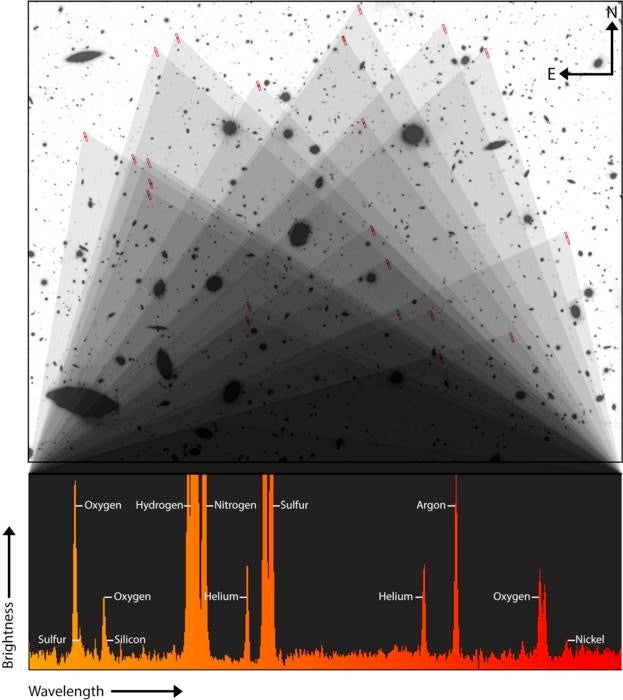
Light from 23 distant galaxies, identified with red rectangles in the Hubble Space Telescope image at the top, were combined to capture incredibly faint emission from eight different elements, which are labelled in the JWST spectrum at the bottom. Although scientists regularly find these elements on Earth, astronomers rarely, if ever, observe many of them in distant galaxies. Credit: Aaron M. Geller, Northwestern, CIERA + IT-RCDS
The James Webb Space Telescope’s (JWST’s) ability to peer back at cosmic dawn has nabbed a lot of attention from scientists and the public — but the machine is just as capable at peering into the universe’s adolescent years.
A study published this month in The Astrophysical Journal Letters looks at some of these awkward years for galactic formation. Allison Strom, a Northwestern University astrophysicist, says that galaxies in this era were in an awkward phase. While infant galaxies are pretty messy and still taking shape, teenage galaxies — those aged about 2 to 3 billion years after the Big Bang — are in somewhat recognizable shapes, but in bulkier ways.
“So, a lot of galaxies at this time are undergoing a lot of mergers, which will always rattle up and shake up the structure,” Strom says. Astronomers are used to many galaxies in the local universe looking like pretty flat disks, but Strom says that teenage galaxies look a bit more like “a filled donut that’s come out of the fryer.” As time goes on and mergers between galaxies complete, they might shape up a bit more.
But that’s not the most surprising part of the findings. The results, which assembled spectra of several galaxies of this era, looking for trends, found an abundance of heavier than expected elements, including nickel.
All the elements, Strom explains, come from different eras of stars. The Big Bang forged hydrogen, helium, and lithium, at least once it cooled down enough for atoms to form at all. Those are the building blocks of the first stars, with beryllium and barium eventually forming as well. But it took until the first supernovae for heavier elements to form.
When you’re talking about the early universe, nickel is really heavy. It took a few generations of stars to create metals in stars (any element heavier than helium) as lithium was typically destroyed when stars ignited. Thus, while nickel was created in some early supernovae, a good chunk of it, too, comes forth from the deaths of sunlike stars.
Stars like the Sun are not massive nough to become supernovae. Instead, they expel their outer shells and leave behind a white dwarf, built mostly of degenerate matter. This process is where a lot of nickel comes from, and explains the abundance of nickel seen by JWST in the CECILIA Survey project, which stands for Chemical Evolution Constrained using Ionized Lines in Interstellar Aurorae.
Whereas huge stars, the kind that explode into supernovae, can live and die within a few million years, lower-mass stars like the Sun need 300 million to 1 billion years to produce white dwarfs, which means our understanding of this era of stars could need a rethink.
Strom says it’s also surprising because, well, you just don’t see nickel in many stellar spectra at all.
“It’s not observed in older galaxies nearby and it’s just not a very common tracer. So, we were just flabbergasted,” she says. “We are not actually even sure what to do with it. Because it’s not been observed enough, there’s not even a standard way of interpreting its presence.”
Future modeling could help explain this relative abundance, which was part of the point of CECILIA — to obtain good datasets of galaxies to help build an understanding of galaxy evolution several billion years after the Big Bang, and to understand what ’s happening with the stars.
In addition to the surprising amounts of nickel, Strom says measurements of N2 (molecular nitrogen) show that the area surrounding forming stars seemed to be about 25 percent hotter than we see in the Milky Way today, possibly a consequence of how hot the overall universe was at the time.
“We can use measurements like that to build up a more detailed picture of how rapidly the galaxies are building themselves,” Strom says. Preliminary results show a surprising amount of argon, which could show a “very extreme” growth spurt from at least one sampled galaxy.
As more data trickles in from JWST, astronomers are going to be able to fill in more bits and pieces of how our early universe took shape. That involves taking a lot of things that have been seen mostly in simulations or modeling up to this point and applying them to observable data. The ability to glance at them in unprecedented detail will inform not just future JWST research, but also how astronomers approach these objects at other observatories. This means we may want to brace for more surprises as time goes on.





